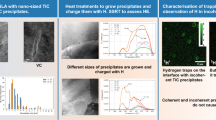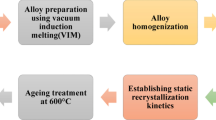Abstract
The oxidation of metals that form P-type semiconducting oxide scales, such as NiO on nickel and CoO on cobalt, takes place by outward cation diffusion and inward vacancy diffusion. The large number of cation vacancies precipitate in the scale near the oxide-metal interface and may coalesce to form macroscopic pores, resulting in a transition from a dense, columnar scale to a duplex scale which contains an inner, fine-grained, equiaxed, porous layer. Increasing temperature and/or purity eliminate the transition, which has been found to depend upon oxide plasticity. The mechanical properties of bulk nickel oxides having a range of porosities have been studied in compression. Three regimes were observed: (1) brittle at low temperatures, (2) ductile at elevated temperatures, and (3) a transition region at intermediate temperatures. Fracture strength in the brittle region was strongly dependent on porosity due to the effect of pores on the elastic modulus and the size of fracture-initiating flaws. The plastic flow stress in the ductile region depended primarily on grain size and impurity content except for very porous materials in which porosity substantially reduced the plastic flow stress. The development of the duplex structure in scales during oxidation has been shown to depend upon inhibition of slip on the {110} 〈110〉 system in the highly textured grains rather than by diffusion-controlled processes such as creep. The duplex structure forms when the rate of deformation of the scale is less than the rate of void formation. Grain size, porosity, and impurities play an important role; all of these effects are discussed in detail.
Similar content being viewed by others
References
O. Kubaschewski and Von Goldbeck,Z. Metallk. 39, 158 (1948).
J. D. Sartell and C. H. Li,J. Inst. Met. 90, 92 (1961).
S. Mrowec,Corr. Sci. 7, 563 (1967).
G. C. Wood, I. G. Wright, and J. M. Ferguson,Corr. Sci. 5, 645 (1965).
D. L. Douglass,Corr. Sci. 8, 665 (1968).
G. C. Wood and I. G. Wright,Corr. Sci. 5, 841 (1965).
F. N. Rhines and J. S. Wold,Met. Trans. 1, 1701 (1970).
D. L. Douglass,Oxid. Metals 1, 127 (1969).
B. M. Vasyutinskiy and G. N. Kartmazov,Fiz. Metal. Metalloved,15, 132 (1963).
D. L. Douglass, ASM National Seminar Proceedings,Oxidation of Metals and Alloys (ASM, Metals Park, Ohio, 1971), p. 137.
A. Dravnicks and H. McDonald,J. Electrochem. Soc. 94, 139 (1948).
I. A. Menzies and K. N. Strafford,J. Mat. Sci. 2, 358 (1967).
I. A. Menzies and P. Aldred,Corr. Sci. 8, 525 (1968).
Y. Iida,J. Amer. Ceram. Soc. 41, 397 (1958).
Y. Iida and S. Ozakis,J. Amer. Ceram. Soc. 42, 219 (1959).
R. W. Davidge and A. G. Evans,Mater. Sci. Eng. 6, 281 (1970).
A. G. Evans, C. Roy and P. L. Pratt,Proc. Brit. Ceram. Soc. 6, 173 (1966).
J. P. Berry,J. Mech. Phys. Solids 8, 194 (1960).
S. R. Anthony, J. P. Chubb, and J. Congleton,Phil. Mag. 22, 1201 (1970).
W. F. Brown and J. E. Srawley, ASTM Special Technical Publication No. 410 (1967).
A. G. Evans and G. Tappin,Proc. Brit. Ceram. Soc. 20 (in press).
H. W. Babel and G. Sines,J. Basic Engr. 90, 285 (1968).
L. E. Simpson.J. Amer. Ceram. Soc. (to be published).
G. W. Groves,Proc. Brit. Ceram. Soc. 15, 103 (1970).
G. W. Groves and A. Kelly,Phil. Mag. 8, 877 (1963).
A. G. Evans,Proc. Brit. Ceram. Soc. 15, 113 (1970).
D. McLean,Mechanical Properties of Metals (Wiley, New York, 1962).
J. P. Hirth and J. Luthe,Theory of Dislocations (McGraw-Hill, New York, 1968).
T. G. Langdon and J. A. Pask,Mat. Sci. Res. 5, 283 (1971).
A. G. Evans and R. W. Davidge,J. Nuclear Mat. 33, 249 (1969).
A. S. Tetelman and A. J. McEvily,Fracture in Structural Materials (Wiley, New York, 1967).
E. M. Passmore, R. M. Spriggs, and T. Vasilos,J. Amer. Ceram. Soc. 48, 1 (1965).
R. F. Cannon, J. T. A. Roberts, and R. J. Beals,J. Amer. Ceram. Soc. 54, 105 (1971).
Author information
Authors and Affiliations
Additional information
Research sponsored by the Office of Naval Research, Mathematics and Information Sciences Division, under Contract ONR N00014-69-A-0200-4021, NR-048-239.
Rights and permissions
About this article
Cite this article
Evans, A.G., Rajdev, D. & Douglass, D.L. The mechanical properties of nickel oxide and their relationship to the morphology of thick oxide scales formed on nickel. Oxid Met 4, 151–170 (1972). https://doi.org/10.1007/BF00613090
Received:
Revised:
Issue Date:
DOI: https://doi.org/10.1007/BF00613090




